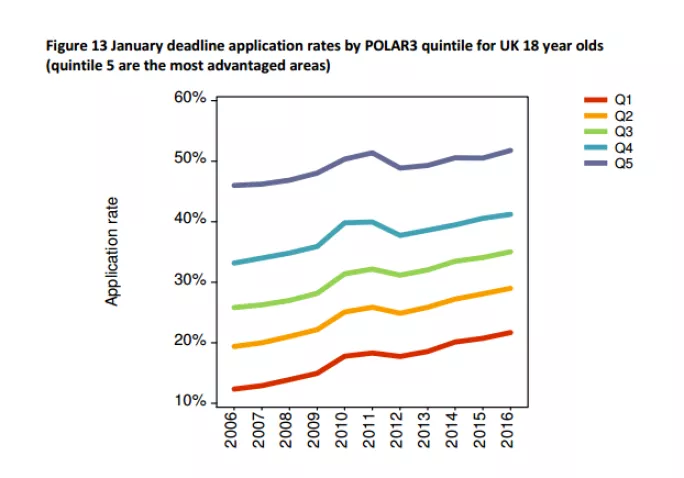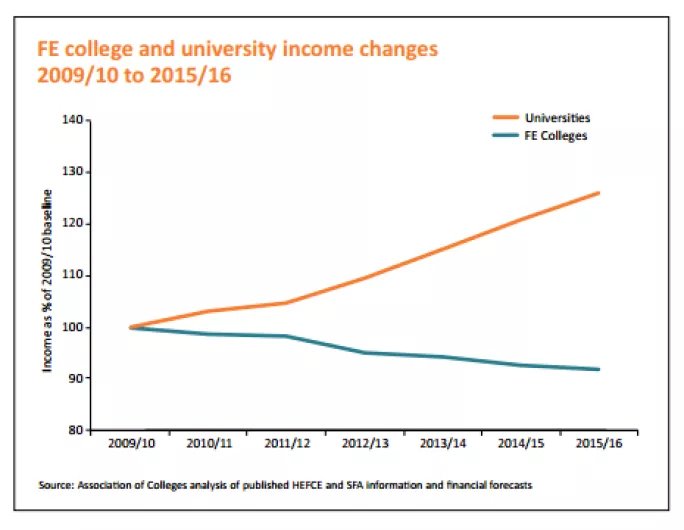- Home
- ‘Don’t tell people with A levels and Btecs they have lots of options, if some of these options aren’t fit for purpose’
‘Don’t tell people with A levels and Btecs they have lots of options, if some of these options aren’t fit for purpose’

In many ways, this year’s A-level results are the calm before the storm. Next year will see the first results from the newly reformed A-levels (and also for GCSEs, a week later). This year is therefore the tail end of the old system - although the AS qualification has been reformed.
The headline pass rate and top grade awards remain basically indistinguishable from last year - 98.1 per cent of entries received at least an E (unchanged from 2015) and 25.8 per cent of grades were an A or A* (down 0.1 percentage points from last year). Ucas data suggests record numbers of students are going to further study - 424,000 students have been accepted to UK universities and colleges at the time of writing, up 3 per cent on last year.
So, beneath the “business as usual” headline, what can we pick out? I think there are six things:
A big fall in AS entries
Whilst overall A-level entries have fallen 1.7 per cent, AS-level entries have fallen by 13.7 per cent.
The fall in numbers for the new, reformed AS is in many ways unsurprising. As a result of the decoupling of AS from the full A level, the former no longer count towards the achievement of the larger qualification. Modules have also been scrapped, so students will have sat one qualification at the end of their Year 12.
Although the points from these qualifications can still be used through Ucas, given the breaking of the link with A levels, the move to a terminal exam and the continued squeeze on post-16 funding, it’s no surprise that this has become a less attractive qualification.
Overall subject falls are not necessarily what they seem
Some of the headline figures so far today have been big falls in the numbers of students taking subjects - for example, French, for which entries have fallen 6 per cent.
The trouble with such statistics is that they take no account of a changing cohort size. In a hypothetical world in which 10 people took A levels last year, of whom five took French, but this year only eight people took A levels and four took French, you could say that French entries have dropped by 20 per cent. But in actual fact, as a proportion of the cohort sitting A levels, it’s remained the same.
The best way to see what’s really going on is to use the Joint Council for Qualifications (JCQ) data, which shows entries in A levels as a proportion of all A levels sat. And then to calculate the percentage point change from 2015 to 2016, and show that as a percentage (with me so far?)
If you do that, you see results like the below:
Entries to selected subjects as % of all entries sat in 2016 and 2015
2015
2016
ppt change
% change
Art and design
5.3
5.2
-0.1
-1.9%
Biology
7.5
7.4
-0.1
-1.3%
Computing
0.6
0.7
0.1
16.7%
Drama
1.6
1.5
-0.1
-6.3%
English
10.5
10.1
-0.4
-3.8%
French
1.2
1.2
0
0.0%
German
0.5
0.5
0
0.0%
General studies
2.1
1.4
-0.7
-33.3%
History
8.8
8.7
-0.1
-1.1%
Maths
10.9
11.1
0.2
1.8%
Music
0.9
0.8
-0.1
-11.1%
PE
1.5
1.4
-0.1
-6.7%
Performing arts
0.3
0.3
0
0.0%
Physics
4.3
4.3
0
0.0%
In other words, for many subjects that seem to have falls - like French - the change is actually almost indistinguishable when you account for changing cohort size. For some subjects, however, there are some big rises and drops.
An increase in clearing
Last year, a record 64,300 students found university places through clearing - around one in eight of all those entering full-time HE. This year, the number is predicted to be even higher. And it’s no longer just less attractive courses on offer - there are 3,900 places on offer this year at Russell Group universities. And for the first time ever, medicine is in clearing - at the prestigious St George’s, University of London
The lesser known companion to clearing is adjustment - which allows those who have done better with their results than predicted to see if they can “trade up” to a higher tariff offer. This is also providing an attractive offer to people.
Partly, this increase in applications once results are known reflects the uncapping of student numbers at universities and consequently a desire amongst some institutions to increase numbers and therefore revenue. But it also seems to reflect a desire for people to make informed choices, not speculative ones.
Twelve years ago, professor Steven Schwartz led a review for the government which recommended the introduction of Post-Qualifications Assessment, or PQA. Although ultimately rejected by government, it seems we may be moving some way towards that by the back door.
Given what we know about how teacher predictions of grades are systematically biased to the downside against pupils with special needs, with bad behaviour, who speak English as an additional language, or who are poorer, it’s probably not just attractive to increasing numbers of students, but also a boost to social mobility as well.
Widening participation...
Recent news reports have been full of gloomy indicators on the costs of HE - with news of an increase in fees, a rise in the numbers of graduates living at home because of debt, and various doom-laden assessments (including from the candidates for the leadership of the Labour party) on the fall of state school students going on to HE.
A lot of this, again, just reflects confusion between raw falls and percentage of the cohort falls (in particular, see this superb explanation from Andrew McGettigan).
The best data to look at is Ucas data, which shows, over time, the percentage of entries (rather than raw numbers) from each of the home nations to university, broken down by socio-economic status. This is unequivocal:

In England, the application rate of 18-year-olds from the most disadvantaged areas has increased from 12.2 per cent in 2006 to 22.0 per cent in 2016. This means that 18-year-olds living in the most disadvantaged areas in England are 81 per cent more likely to apply to higher education in 2016 than 10 years ago.
…driven by an increase in access to HE for those who didn’t take A-levels
It’s easy to forget that only a minority of 17- and 18-year-olds actually take A levels, as opposed to other more technical qualifications. The SMF has put out some great data today showing the increase of those with Btecs going on to HE
- Almost 100,000 students (one in four) entering university now have a Btec qualification, compared with just under 50,000 in 2008;
- Acceptance of those with Btecs and a combination of Btecs and A levels is increasing rapidly, and the proportion has almost doubled in the past eight years. In 2008, just 14 per cent of those accepted into higher education had a Btec - in 2015 more than a quarter (26 per cent) did;
- Increasing numbers of young people taking at least one vocational qualification at key stage 5 have very good GCSE results. In 2015, 37 per cent of young people taking a KS5 vocational qualification had at least five A* to C GCSEs or equivalents. Increasing numbers of young people taking Btecs or a combination of Btecs and A levels are also achieving high grades at KS5, and then progressing into higher education.
University vs apprenticeships
No, it’s not a competition. But that hasn’t stopped advocates for both routes loudly trumpeting the reasons for young people with A levels to choose one over the other.
My view on this is pretty clear. I’ve long argued that those who have decried the rise in the HE participation rate are profoundly misguided. The increase in HE - driven significantly by those from a more modest socio-economic background - is a boon to this country. The generous financial settlement for students also makes it an incredibly good deal, value for money-wise.
However, this is not to also say that HE hasn’t been living high on the hog for some time, at the direct expense of FE and more technical routes. A quick look at funding over the last parliament makes this abundantly clear:

So I’m all in favour of those from whatever background to go to HE if they want to. But if they don’t want to, then they deserve an equally prestigious route through higher level technical education, including (but not limited to) apprenticeships.
My concern about apprenticeships is that, whilst some of them are clearly amazing, a worrying number are not. A detailed look at the content required under the new “standards” (effectively the syllabus) for too many shows a lack of ambition for the apprentice, and a weak method for assessing quality. This is the subject of current work by the Policy Exchange thinktank. There is no point telling young people (and indeed all adults) holding a fistful of A levels and Btecs that they have a wide range of options, if some of them turn out not to be fit for purpose.
Jonathan Simons is a former head of education in the Prime Minister’s Strategy Unit under Gordon Brown and David Cameron
Want to keep up with the latest education news and opinion? Follow TES on Twitter and like TES on Facebook
Keep reading for just £1 per month
You've reached your limit of free articles this month. Subscribe for £1 per month for three months and get:
- Unlimited access to all Tes magazine content
- Exclusive subscriber-only stories
- Award-winning email newsletters



